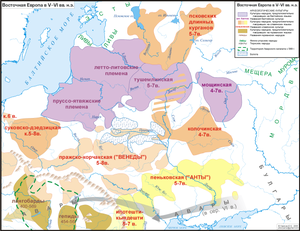Kolochin culture
The Kolotschin culture (Russian Колочинская культура ) was a Slavic archaeological culture from the 5th to 7th centuries in what is now Russia , Belarus and Ukraine .
Distribution area
The Kolotschin culture lay on the Desna , Sejm and other rivers in today's Russian Oblast Kursk and Brjansk , the Belarusian Woblasz Homel and the Ukrainian Oblast Chernihiv .
It is named after a settlement near Kolotschin in the Woblasz Homel . The Kolotschin culture bordered in the west on the related Slavic Korchak culture , in the northwest on the Baltic Tuschemlja culture , in the north on the Baltic Moschtschiny culture and in the southwest on the related Slavic Penkowo culture .
The carriers of the culture were unknown early Slavic tribes. It was the easternmost Slavic culture of its time.
Today around 150 sites (settlements and burial grounds) are known.
Emergence
The Kolotschin culture emerged in the 5th century from the Kiev culture and expanded northwards into the Baltic area of the Tuschemlja culture until then .
Everyday culture
The livelihoods were agriculture and animal husbandry, but also hunting and fishing. Iron was processed (knives, sickles). There were also objects made of bronze or silver (chokers, fibulas, bracelets).
The settlements were on rivers and lakes, some on terraces or spurs, and were unpaved. The houses were sunk into the earth, square and small.
The pottery was bare and hand formed.
Burials took place in urns with corpses in burial fields. Additions were ceramics and jewelry.
Changes
In the 7th century, the Wolyn culture developed , probably belonging to the Slavic tribe of the Severyan .
Web links
literature
- PM Barford: The Early Slavs: Culture and Society in Early Medieval Eastern Europe , chap. 2-4, 2001
Remarks
- ↑ EA Simonowitsch: Городище Колочин I на Гомельщине ( Kolotschin I castle wall in the Gomel region ), in: Материалы и исследования по археолог3С , No..108С, 196С

